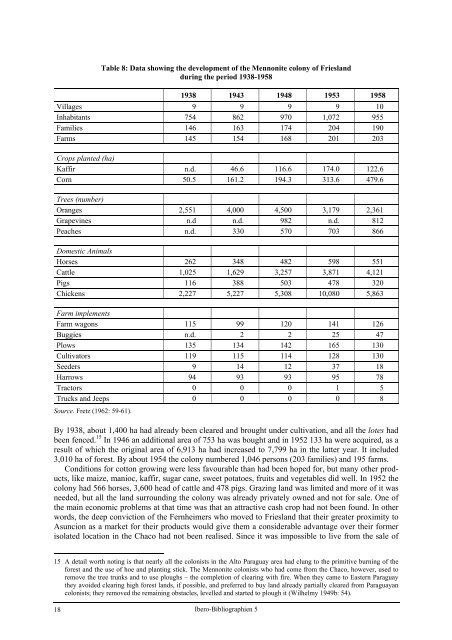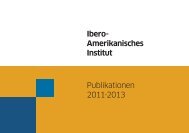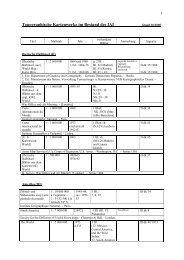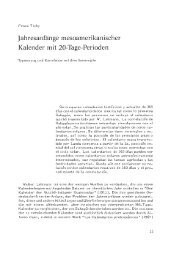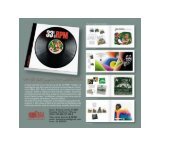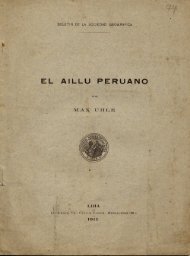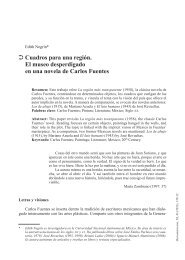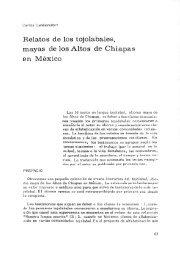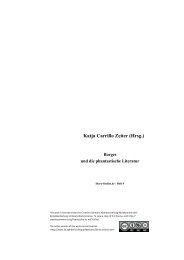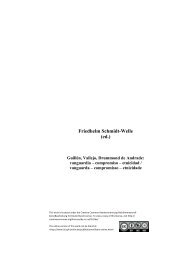The Mennonite Colonies in Paraguay. Origin - Ibero-Amerikanisches ...
The Mennonite Colonies in Paraguay. Origin - Ibero-Amerikanisches ...
The Mennonite Colonies in Paraguay. Origin - Ibero-Amerikanisches ...
Create successful ePaper yourself
Turn your PDF publications into a flip-book with our unique Google optimized e-Paper software.
18<br />
Table 8: Data show<strong>in</strong>g the development of the <strong>Mennonite</strong> colony of Friesland<br />
dur<strong>in</strong>g the period 1938-1958<br />
1938 1943 1948 1953 1958<br />
Villages 9 9 9 9 10<br />
Inhabitants 754 862 970 1,072 955<br />
Families 146 163 174 204 190<br />
Farms 145 154 168 201 203<br />
Crops planted (ha)<br />
Kaffir n.d. 46.6 116.6 174.0 122.6<br />
Corn 50.5 161.2 194.3 313.6 479.6<br />
Trees (number)<br />
Oranges 2,551 4,000 4,500 3,179 2,361<br />
Grapev<strong>in</strong>es n.d n.d. 982 n.d. 812<br />
Peaches n.d. 330 570 703 866<br />
Domestic Animals<br />
Horses 262 348 482 598 551<br />
Cattle 1,025 1,629 3,257 3,871 4,121<br />
Pigs 116 388 503 478 320<br />
Chickens 2,227 5,227 5,308 10,080 5,863<br />
Farm implements<br />
Farm wagons 115 99 120 141 126<br />
Buggies n.d. 2 2 25 47<br />
Plows 135 134 142 165 130<br />
Cultivators 119 115 114 128 130<br />
Seeders 9 14 12 37 18<br />
Harrows 94 93 93 95 78<br />
Tractors 0 0 0 1 5<br />
Trucks and Jeeps 0 0 0 0 8<br />
Source. Fretz (1962: 59-61).<br />
By 1938, about 1,400 ha had already been cleared and brought under cultivation, and all the lotes had<br />
been fenced. 15 In 1946 an additional area of 753 ha was bought and <strong>in</strong> 1952 133 ha were acquired, as a<br />
result of which the orig<strong>in</strong>al area of 6,913 ha had <strong>in</strong>creased to 7,799 ha <strong>in</strong> the latter year. It <strong>in</strong>cluded<br />
3,010 ha of forest. By about 1954 the colony numbered 1,046 persons (203 families) and 195 farms.<br />
Conditions for cotton grow<strong>in</strong>g were less favourable than had been hoped for, but many other products,<br />
like maize, manioc, kaffir, sugar cane, sweet potatoes, fruits and vegetables did well. In 1952 the<br />
colony had 566 horses, 3,600 head of cattle and 478 pigs. Graz<strong>in</strong>g land was limited and more of it was<br />
needed, but all the land surround<strong>in</strong>g the colony was already privately owned and not for sale. One of<br />
the ma<strong>in</strong> economic problems at that time was that an attractive cash crop had not been found. In other<br />
words, the deep conviction of the Fernheimers who moved to Friesland that their greater proximity to<br />
Asuncion as a market for their products would give them a considerable advantage over their former<br />
isolated location <strong>in</strong> the Chaco had not been realised. S<strong>in</strong>ce it was impossible to live from the sale of<br />
15 A detail worth not<strong>in</strong>g is that nearly all the colonists <strong>in</strong> the Alto <strong>Paraguay</strong> area had clung to the primitive burn<strong>in</strong>g of the<br />
forest and the use of hoe and plant<strong>in</strong>g stick. <strong>The</strong> <strong>Mennonite</strong> colonists who had come from the Chaco, however, used to<br />
remove the tree trunks and to use ploughs – the completion of clear<strong>in</strong>g with fire. When they came to Eastern <strong>Paraguay</strong><br />
they avoided clear<strong>in</strong>g high forest lands, if possible, and preferred to buy land already partially cleared from <strong>Paraguay</strong>an<br />
colonists; they removed the rema<strong>in</strong><strong>in</strong>g obstacles, levelled and started to plough it (Wilhelmy 1949b: 54).<br />
<strong>Ibero</strong>-Bibliographien 5


